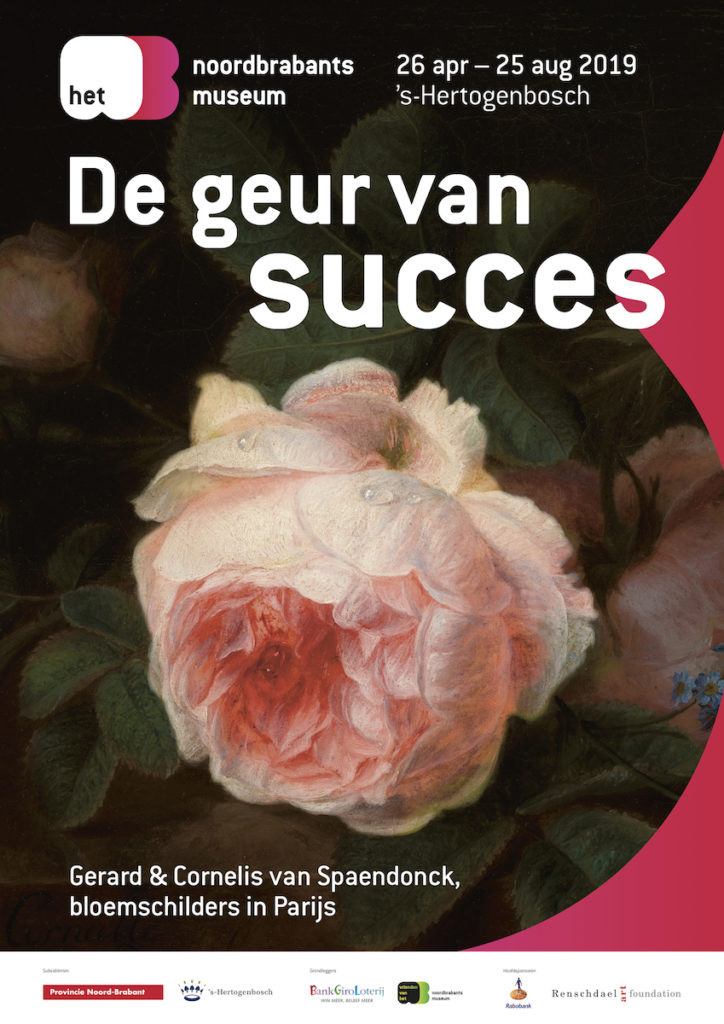The Smell of Success: Gerard & Cornelis van Spaendonck, Painters of Flowers in Paris is at Het Noordbrabants Museum in ’s-Hertogenbosch, the Netherlands from 26 April to 25 August 2019. It is accompanied by Paul Huys Janssen, De geur van succes. Gerard & Cornelis van Spaendonck, bloemenschilders in Parijs (Zwolle: WBOOKS, 2019).
The contemporary French artist Camile Henrot once asked in an exhibition: “Is it possible to be a revolutionary and like flowers?” Her question speaks to the perception of flower painting as an apolitical genre, a prejudice that certainly affects Gerard and Cornelis van Spaendonck and their favored subjects, floral still lives. Born in Tilburg, Gerard and Cornelis van Spaendonck emigrated to Paris in 1769 and 1779 respectively, became members of the Académie, and enjoyed critical and financial success from the reign of Louis XVI to the Bourbon Restoration. Their enduring popularity in this period and their fidelity to flower pieces amidst profound social and political upheaval positions them at the forefront of Henrot’s inquiry.
The perceived golden age of flower painting has long overlapped with the Dutch Golden Age, with Jan Davidsz. de Heem and Rachel Ruysch as leading representatives of the genre. While Jan van Huysum’s floral still lives cost more than a painting by Rembrandt in eighteenth-century Paris, flower paintings remained at the bottom of the academic hierarchy, as André Félibien outlined in his 1667 conference to the Académie royale de peinture et de sculpture.[1] Scholars have since regarded them as part of a genre centered on illusionism (Taylor); as symbolic expressions of Dutch cultural values (Schama); as objects traversing economic realms of the garden, flower trade, and art market (Bryson); or as linked to cultural distinctions associated with floriculture (Hyde).[2] Yet the prime positions occupied by two Dutch émigrés and the material diversity of their artistic productions calls for a reconsideration of floral still lives at the twilight of the Ancien Régime.
The Smell of Success: Gerard & Cornelis van Spaendonck, Painters of Flowers in Paris at the Het Noordbrabants Museum is the first exhibition devoted to the van Spaendonck brothers since 1980, when one was held in the same museum.[3] In the intervening four decades, they have been eclipsed by studies of Gérard’s protégé, Pierre-Joseph Redouté, the anointed Raphael of flowers. Elsewhere, their works have been upheld as prime examples of Hollandisme in France at the end of the eighteenth century, and as the starting point for a long list of Dutch artists in Paris that extends to Van Gogh and Van Dongen as represented by the exhibition The Dutch in Paris: 1789-1914 (Van Gogh Museum, Amsterdam and Petit Palais, Paris, 2017-2018).
Organized by curators Joris Westerink and Paul Huys Janssen, The Smell of Success recounts a familiar story of émigrés who found financial and critical fortune in Paris, only to claim them as essentially Dutch artists in form and content. This reductive approach is echoed in the accompanying catalogue, which curiously centers on Adriaan van der Willigen (1766-1841), a Dutch soldier, art collector, and writer whose diary serves as the primary window into the lives of the Van Spaendonck brothers. The indebtedness of the brothers to their homeland is echoed in the selection of objects. Of the 130 works in the exhibition, one quarter are taken from the museum’s permanent collection, and one quarter from the artists’ descendants, managed by the Joannes Antonius van Spaendonck Foundation.
Instead of a chronological or thematic approach, the show is organized by media. The spotlight is largely on Gerard, who rapidly ascended the Paris art world under the patronage of Claude-Henri Watelet and later with the support of the comtes de Buffon and d’Angiviller. Gerard accrued an enviable list of titles and positions: peintre en miniature du Roi, member and conseiller of the Académie, member of the Classe des Beaux-arts at the Institut national de France, Chaire d’Iconographie naturelle at the Jardin des plantes (a position created for him and eliminated following his death), and receiver of a Légion d’honneur from Napoleon. While nowhere near as celebrated, Cornelis prospered as a member of the Académie and briefly as Directeur artistique of the Sèvres porcelain manufactory (1795-1800).
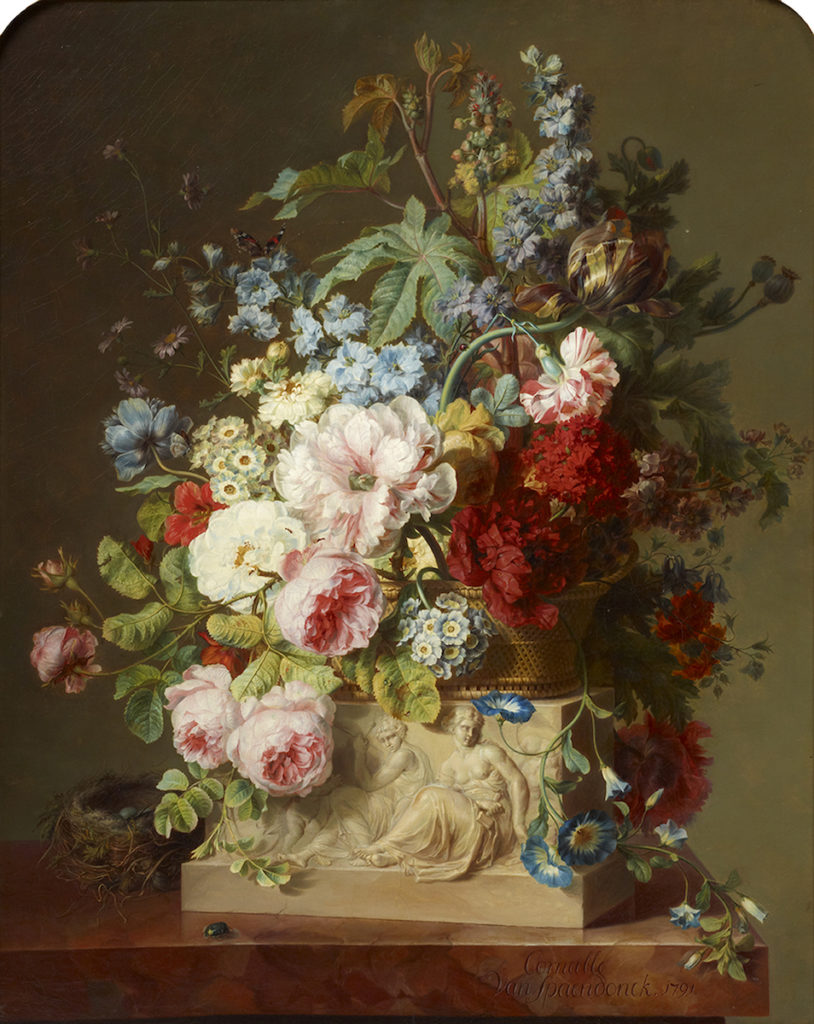
In the section devoted to paintings, the lack of individual explanations in exhibition wall labels and the arbitrary inclusion of eighteenth- and nineteenth-century period furniture reduce the paintings to the realm of the decorative. The broad label of “Dutch flower paintings” and the emphasis on financial motivations promoted in the exhibition do disservice to the cultural richness of these works. How might their compositions relate to the earlier French traditions of floral still lives in the vein of Jean-Baptiste Monnoyer? How did Gerard’s dual position on both sides of the Seine—in the circle of naturalists at the Jardin du Roi (later Jardin de Plantes) and among painters and amateurs at the Académie—impact his engagement with both naturalist and academic traditions? Through which avenues did Cornelis’s role at Sèvres intersect with his continued production of paintings in the style of his older brother (Fig. 1)? What of their relationship to their chief rival in the genre, Anne Vallyer-Coster?
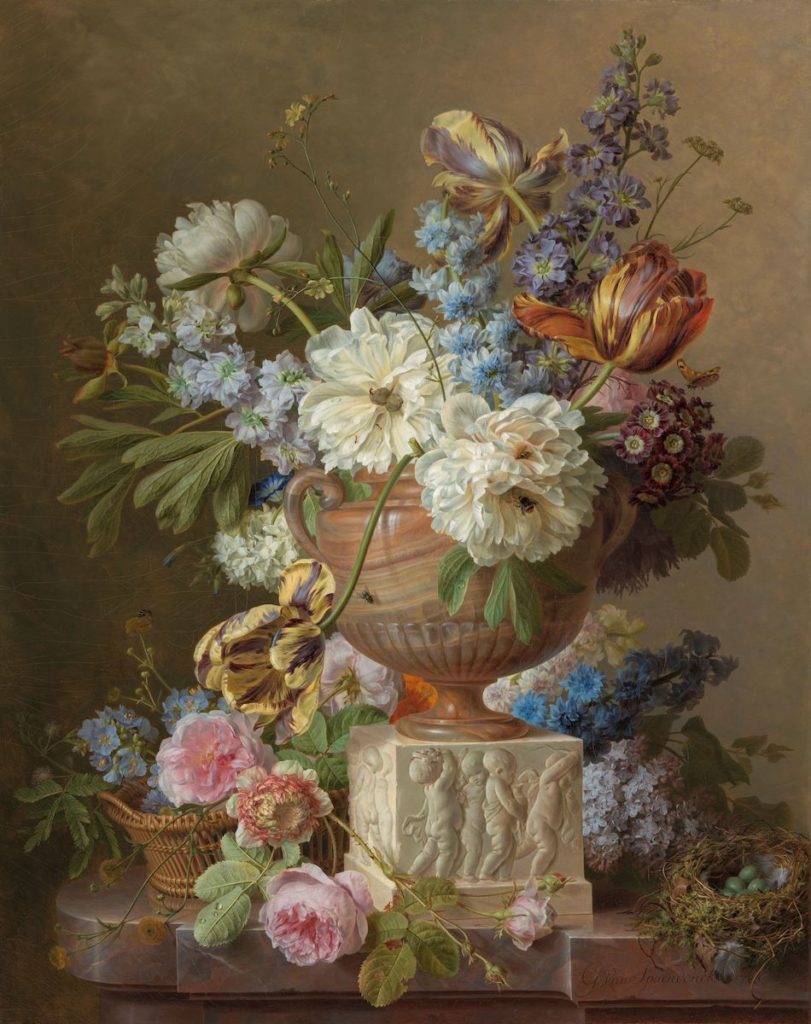
While such questions remain unaddressed, the paintings nonetheless stand out for their seductive handling of color and for the ineluctable vitality of the depicted flowers. The exhibition includes several of Gerard’s paintings for the Salon, where he consistently exhibited paintings and drawings from 1777 to 1796. His painting for the Salon of 1783 (Fig. 2) reveals in particular the underlying nexus of artistic and theoretical concerns in his compositions. Iridescent peonies, primula, lilacs, and auricles are arranged in an alabaster vase, highlighting flowers as decorative luxuries, as well as in a wicker basket, as if the blooms had been freshly collected from outside. The juxtaposition of the bird’s nest against the basket emphasizes the creative power of the natural world against artisanal craft, and Gerard’s mastery over different types of reflected light like glans (the essential Dutch art of sheen or luster) and the reflection of his studio window on the vase proclaim the dominance of the painter’s craft over natural representation.[4] The chromatic emphasis on tulips and hyacinths allude to their economic speculation in the 1630s and 1730s, respectively, and the overall composition underscores how the flowers, the vase, the sculpture, and the painting itself are all embedded in the world of goods. Salon critics and colleagues at the Jardin du Roi alike noted that Gerard’s flower paintings lay at the intersection of art, science, industry, and commerce and bridged the production of nature with the industriousness of French manufactories. Yet instead of unpacking some of this layered complexity, the exhibition leans toward the other end of the spectrum. One display amplifies a small painting on marble of a cabbage rose (Fig. 3) to baroque proportions (Fig. 4) by means of a gargantuan steel, tarp, and wool construction by Linda Nieuwstad, apparently to stress the artificial and decorative nature of the image.
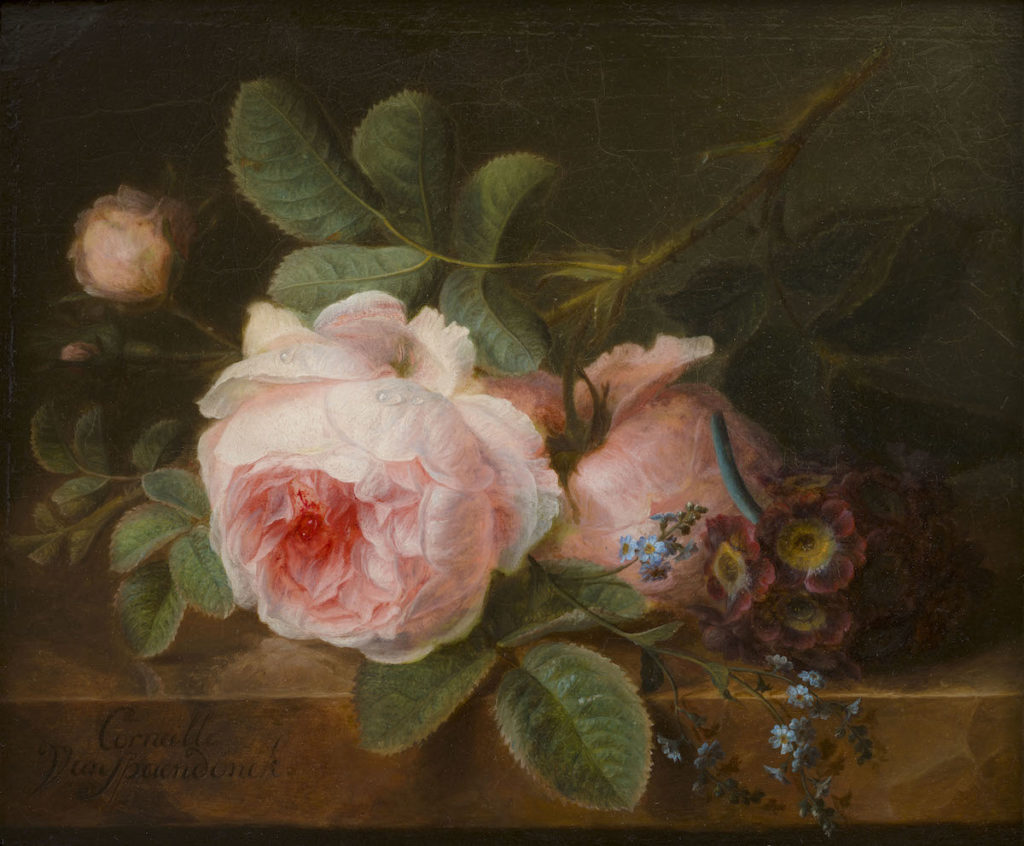
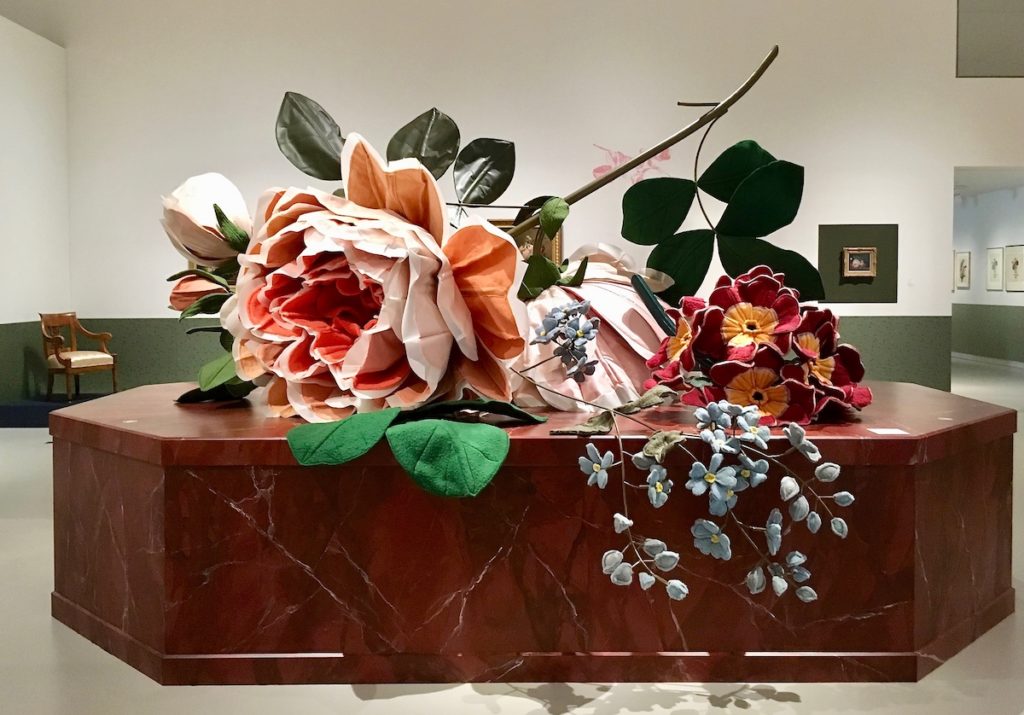
In a long gallery of drawings and engravings, works by Gerard vastly outnumber those by his brother. On display are highly finished drawings in graphite, broad studies in oil paint, and tentative explorations in watercolor. Gerard’s drawing of rosebuds (Fig. 5) chronicle his early attempts with watercolor and his pleasure in experimenting with the medium rather than following conventions of natural history illustrations based on Linnean taxonomy. Watercolor was particularly integral to Gerard’s contribution for the vélins du roi, mention of which is surprisingly absent in the wall text. The vélins were a collection of naturalist drawings of flora and fauna on vellum originally made for Gaston, duc d’Orléans, the brother of Louis XIII. During the eighteenth century, growing collections of vélins embodied the reach and geographical dominion of the French monarchy. One of Gerard’s chief responsibilities was their production, and while he was nowhere near as prolific as his predecessor Madeleine de Basseporte—who produced 313 vellums to Gerard’s fifty-six—he was the first to use watercolor in place of gouache for these highly precise natural history drawings. Georges Cuvier, then Director of the Muséum d’histoire naturelle, observed that Gerard’s roles as painter, professor, and naturalist positioned his paintings and drawings as essential counterparts to lectures by the influential French botanist Antoine Laurent de Jussieu.[5] Better contextualization of Gerard’s drawings would have signaled how his multiple responsibilities impacted his graphic production, challenging the exhibition’s distinction between preparatory and independent works.
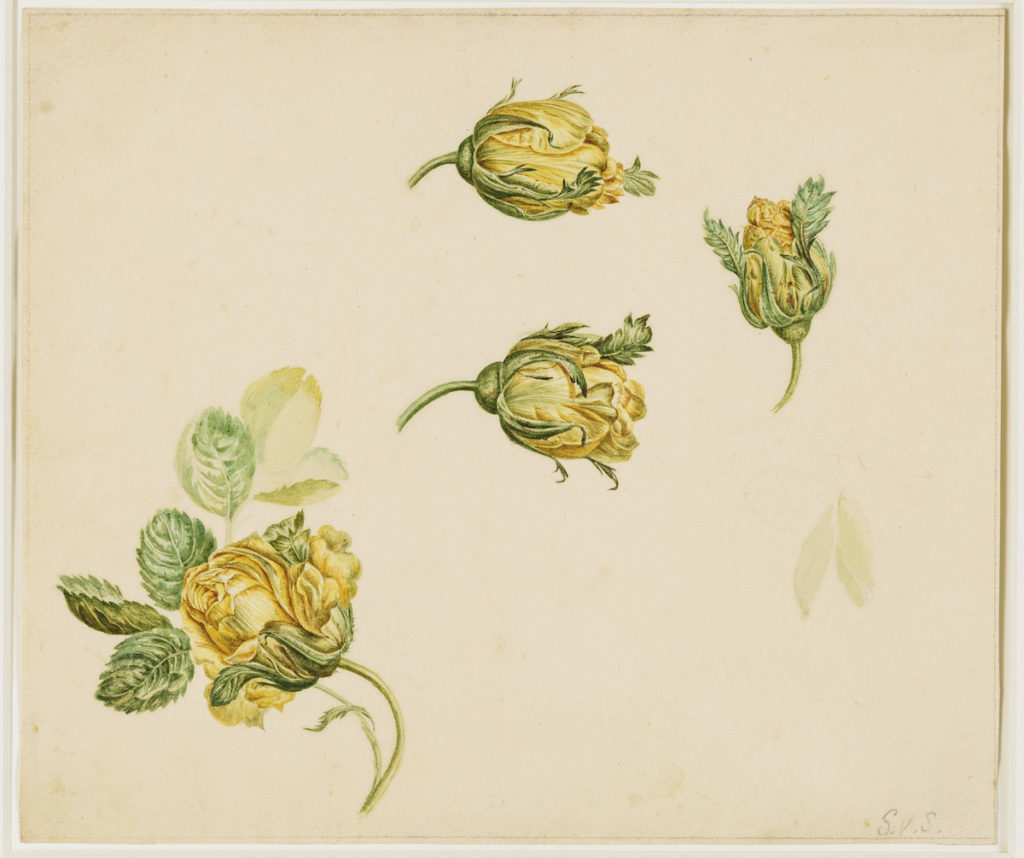
Nestled amongst drawings and prints are a selection of miniatures. Both Gerard and Cornelis decorated bonbonnières, tabatières, and brooches with compositions often replicating or serving as pendants to larger paintings. For Gerard, miniatures (Fig. 6) paved his success at court and were appreciated simultaneously as objects of luxury and taste as well as prime currency in the “commerce of friendship.”[6] Instead of installing the miniatures alongside works on paper, perhaps the curators could have displayed them next to their larger counterparts on canvas, so as to highlight the compositional and technical affiliations between them and to stress the importance of miniatures not only to the flower genre but also to the brothers’ success.
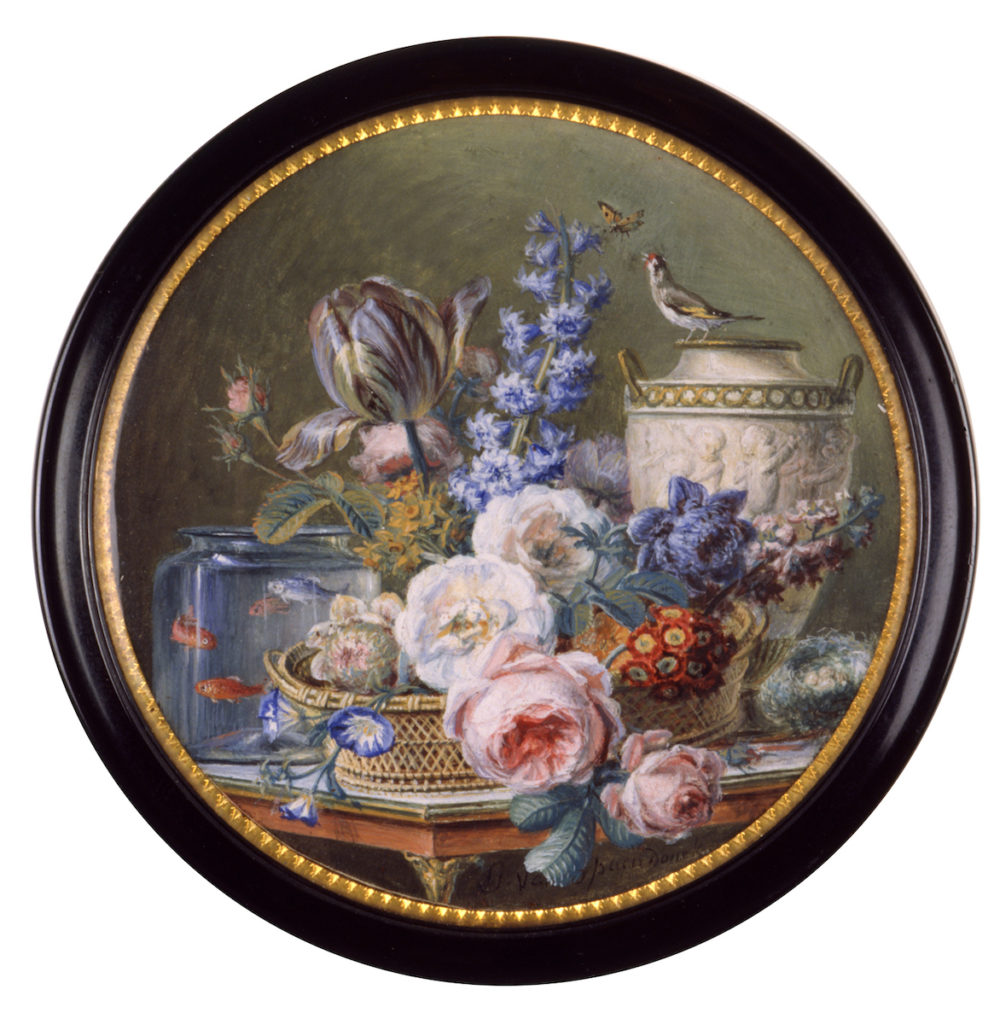
The exhibition’s final section focuses on prints after drawings by Gerard and Cornelis. It largely centers on Fleurs dessinées d’après nature (Chez l’auteur, Bance, 1799-1801), which consists of 24 stipple engravings after drawings by Gerard. Five different engravers were chosen by the artist, owing to his concern with faithful technical translation of his prints. The shortcomings of this section lie in the omission of outlining different techniques of printmaking. It narrates the van Spaendoncks’ turn to printmaking as financially driven rather than positioning their works alongside other floral engravings after Basseporte, Monnoyer, Pillement and Charles-Germain de Saint-Aubin that were oriented more toward students, craftsmen, and manufactories. Gerard in particular used drawings and prints for his own pedagogical practice, and missing is any discussion of the formative influence he had on his pupils, which included (in addition to Redouté) Frans Dael, Pancrace Bessa, and dozens of women amateurs and artists including Thérèse Baudry de Balzac and the marquise de Grollier. The latter’s dazzling homage to Van Spaendonck in the collection of the Los Angeles County Museum of Art (Fig. 7) might have helped elucidate the undercurrents of friendship, sociability, consumerism, and pedagogy at the heart of the brothers’ financial and academic success.
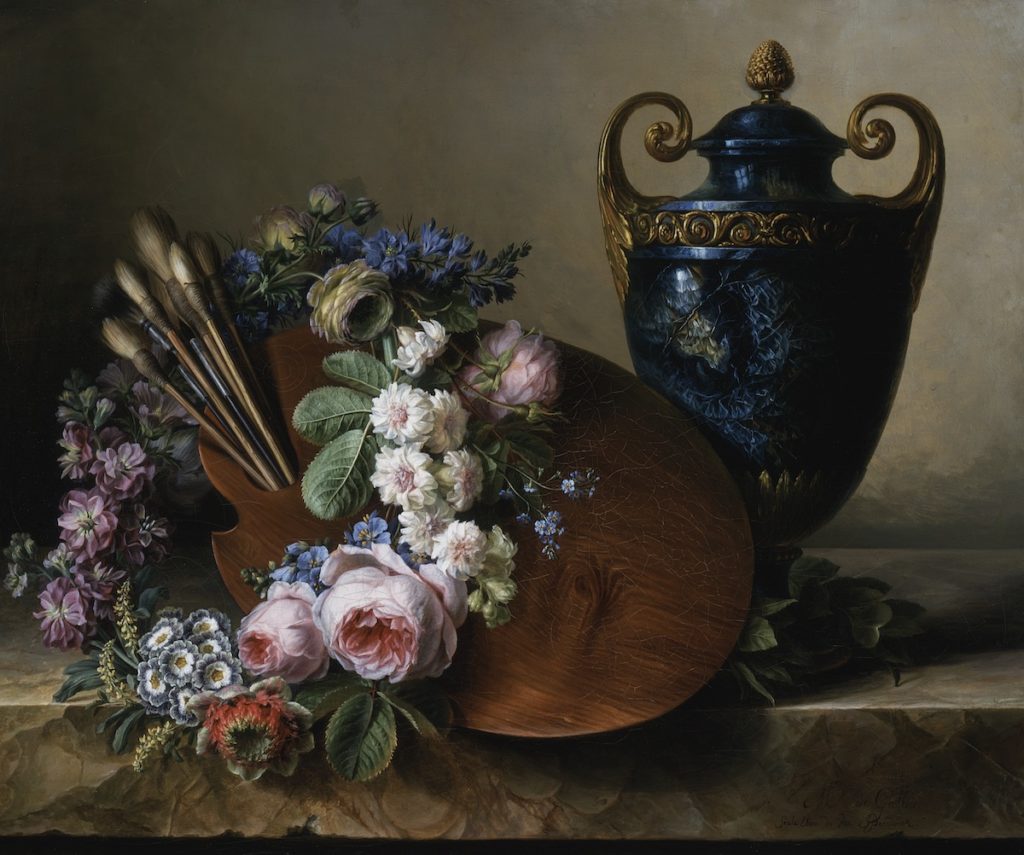
Was it thus possible to be a revolutionary and like flowers? In his eulogy to Gerard van Spaendonck, Quatremère de Quincy remembered that Gerard “remained faithful to his vocation and procured for himself, in the liaison of his art with the natural sciences, a refuge from the storms of the revolution.”[7] In the art of the van Spaendonck brothers, their negotiations with different media, institutions, and their reconciliation of microscopic scientific fidelity and the art of imagination secured their works in naturalists’ libraries, galleries of amateurs, and the public eye throughout the revolution. Gerard van Spaendonck’s legacy lingered well past the eighteenth century and continued to represent a certain model of art. Théophile Gautier notably compared Eugène Delacroix’s two flower paintings in the Salon of 1849 as diametrically opposed to those by Van Spaendonck.[8] In this, the Den Bosch exhibition provides a rare opportunity for all to experience the van Spaendoncks’ astonishing pictures, to consider an understudied aspect of artistic production that persisted during the revolutionary era, and to remember their far-reaching legacy in the nineteenth century and beyond.
Cabelle Ahn is a PhD Candidate in History of Art & Architecture at Harvard University in Cambridge, MA
[1] François-Charles Joullain, Réflexion sur la peinture et la gravure, accompagnées d’une courte dissertation sur le commerce de la curiosité, et les ventes en général, 1781), 60; Peter Carpreau, “‘La fraîcheur qu’offre la nature’, Some Remarks on the Auction Price Evolution of Flower Still Lifes in the Eighteenth Century,” in Dries Lyna, Filip Vermeylen, and Hans Vlieghe, eds., Art Auctions and Dealers: The Dissemination of Netherlandish Art During the Ancien Régime (Turnhout: Brepols, 2009), 155-168.
[2] Elizabeth Hyde, Cultivated Power: Flowers, Culture, and Politics in the Reign of Louis XIV (Philadelphia: University of Pennsylvania Press, 2016), 116.
[3] Accompanied by the catalogue Margriet van Boven and Sam Segal, Gerard & Cornelis van Spaendonck: Twee Brabantse bloemenschilders in Parijs (Maarssen: Schwartz, 1988), which still serves as the definitive catalogue raisonné for the two artists.
[4] Karel van Mander noted five different kinds of reflections in chapter seven of Het Schilderboek (1604): mirroring, reflection, polish, re-reflection, and reverberation. See Walter S. Melion, Shaping the Netherlandish Canon: Karel van Mander’s Schilder-boeck (Chicago: University of Chicago Press, 1991), 70-74.
[5] Antoine-Chrysostome Quatremère de Quincy and Georges Cuvier, Funérailles de M. Van-Spaendonck (Paris: Fermin Didot, 1822), 6.
[6] Quatremère de Quincy, “Éloge Historique de M. Van Spaendonck, 5 Octobre 1822,” in Quatremère de Quincy and Jean-Nicolas Huyot, eds., Séance publique de l’Académie royale des Beaux-arts du 5 Octobre 1822 (Paris: Chez Firmin Didot, libraire, imprimeur du Roi, et de l’Institut, rue Jacob, n. 24), 3.
[7] Quatremère de Quincy and Cuvier, Funérailles de M. Van-Spaendonck, 3.
[8] Théophile Gautier, “Salon de 1849 (Cinquième article),” La Presse (August 1, 1849), 2.
Cite this note as: Cabelle Ahn, “The Smell of Success: A Review,” Journal18 (July 2019), https://www.journal18.org/3938.
Licence: CC BY-NC
Journal18 is published under a Creative Commons CC BY-NC International 4.0 license. Use of any content published in Journal18 must be for non-commercial purposes and appropriate credit must be given to the author of the content. Details for appropriate citation appear above.

